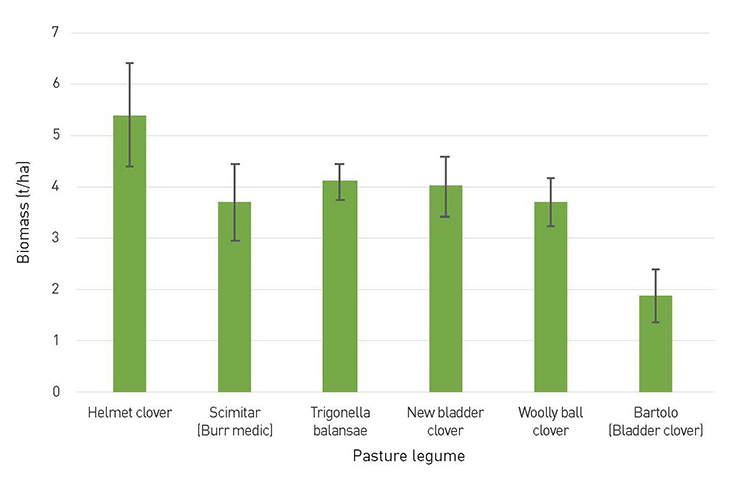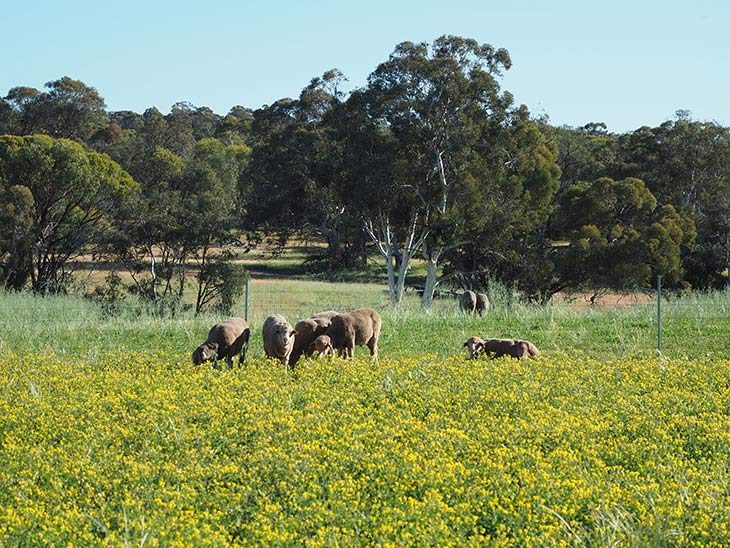Herbage availability for arrowleaf clover, established either by summer sowing of unprocessed seed (left of photo) or via conventional sowing (late May) of scarified seed (right of photo) in late winter at Condobolin, NSW in 2020. PHOTO: Dr Belinda Hackney
A collaborative project is looking at increasing the feed supply on mixed farms with acidic and alkaline soils in the medium-low rainfall zones through summer sowing legumes and the development of new legume species.
The Dryland Legume Pasture Project (DLPS) funded by AWI in collaboration with the Department of Agriculture Water and Environment, GRDC and MLA – in WA, NSW, SA and Victoria – is investigating the capacity of hardseeded annual legumes to improve feed supply and reduce risk in mixed farming systems. Researchers from Murdoch University, NSW DPI, DPIRD, SARDI, CSIRO, Charles Sturt University and Frontier Farming Systems are leading this national research effort.
After emerging from recent widespread drought, growers throughout the mixed farming zone are faced with the need to renovate paddocks where favourable pasture species were lost or severely depleted. Hardseeded annual pasture legumes investigated in this project were significantly more productive than traditional legumes throughout the drought in NSW and WA. They also set more seed to ensure regeneration post-drought. These legumes offer opportunity to establish pastures in novel ways that better integrate with other on-farm enterprises. They also allow woolgrowers to more reliably produce high quality feed for a longer period of time throughout the growing season and under variable climatic conditions to reduce feed gaps. This means there is greater capacity to match feed supply with sheep nutritional needs, especially for classes of sheep requiring higher quality forage such as weaners and pregnant and lactating ewes to optimise growth rates and wool cut.
Renovating pastures can be an expensive process, partly due to the laborious and multi-step seed harvesting and processing required for traditional species such as subterranean clover and annual medics. In mixed farming systems, most pastures containing traditional legumes are sown after the danger of false breaks have passed and often after the winter cropping program is complete. As temperatures decline, the emergence time for pasture legumes increases dramatically and late sown pastures often produce little herbage in the establishment year. Small seedlings of traditional shallow-rooted legumes produced by conventional sowing can struggle to survive moisture stress periods in spring. As a result, seed production is compromised leading to poor regeneration capacity in subsequent years.
Hardseeded legumes such as serradella, biserrula, gland clover, bladder clover and arrowleaf clover produce and retain their seed aerially. Seed can be harvested using a conventional cereal header. Seed yields of 300-1500 kg seed/ha are commonly achieved on-farm, depending on species and growing conditions. Seed harvested from these legumes can be sent for processing (scarification) for sowing in a conventional manner in mid- to late-autumn, but there is opportunity to utilise the seed in its unprocessed form.
Summer sowing was developed in WA by Murdoch University and DPIRD researchers Drs. Brad Nutt, Angelo Loi, Ron Yates and Professor John Howieson. Unprocessed seed is sown in mid- to late-summer. Fluctuation between day and night temperatures and moisture break down the hard seed. Some seed is then capable of germination on opening growing season rainfall. Seedlings emerge rapidly while the temperatures are favourable, significantly increasing herbage production in the establishment year. The root systems of these species develop rapidly and extend deep into the soil profile (1.3-1.8 m compared to
The capacity to produce and harvest seed on-farm at a fraction of the cost of buying seed means higher seeding rates can be used. For summer sowing, seeding rates of 20-30 kg/ha of serradella pod or 12-15 kg/ha of unprocessed clover or biserrula seed are suggested. In practice, many farmers producing their own seed sow at rates higher than this.
Summer sowing requires inoculant (rhizobia) to be delivered in a way that ensures its survival even under very high summer temperatures. Clay-based granules impregnated with appropriate rhizobia for the species sown have proved very successful for this purpose.
Summer sowing is proving successful not only in WA but also in NSW and is being explored in SA and Victoria. Experiments have been conducted under some of the driest years on record and have found summer sowing increased feed supply at the end of winter by 4- to 10-fold compared to the same species sown conventionally. Total herbage produced for the growing season was increased by 2- to 10-fold (see photo above and video at wool.com/legumes, showing herbage biomass at end of winter) at sites in NSW run by Dr Belinda Hackney's NSW DPI team. With higher levels of herbage available, there is capacity for some utilisation in the establishment year. Modelling using GrazFeed showed summer sown treatments utilised in late winter could achieve wool growth gains of 20-25 g/hd/d and liveweight gains of 360-450 g/hd/d for Merino weaners compared to a maximum wool growth gain of
Summer sowing increased seed production in the establishment year which is critical for strong regeneration. Once a seedbank is established, growers have greater flexibility in terms of future paddock use than for traditional pasture species. Species such as biserrula have very high levels of hard seed which break down slowly under WA and SA summer-autumn conditions and it is generally advisable in those regions to crop biserrula paddocks in the second year. For other hardseeded legumes (and for biserrula in NSW), somewhere between 30 and 50% of seed produced in the establishment year, depending on seasonal rainfall and temperature conditions, has softened in the paddock by the following autumn and is capable of germination. Therefore, growers can choose between cropping the paddock or allowing it to regenerate for grazing. Some growers choose to sow moderate rates of cereal over paddocks with established seedbanks to provide a better energy-protein balance for grazing or to take through for use as silage or hay. Paddocks with an established hardseeded legume seedbank are capable of regenerating after cropping phases without the need for resowing. This provides capacity to switch between using paddocks for grazing or cropping more rapidly and with less risk than in conventional systems.
Summer rainfall patterns have a significant impact on which legumes can be used for summer sowing. In summer-dry WA and SA, hardseeded French serradella cultivars and bladder clover work well as summer sow options. In NSW, in addition to French serradella and bladder clover, arrowleaf clover, gland clover, biserrula and some cultivars of yellow serradella are also successful, due to higher incidence of rainfall in summer resulting in increased hard seed breakdown.
The project is also working on the development of new legume species and additional varieties of existing species. Already a new, earlier flowering French serradella, Fran2o, has been released for lower rainfall areas and sufficient seed has been produced in the first year of its release for sowing of more than 3,000 ha.
Developing header-harvestable, deep-rooted legume options that are suited to summer sowing for neutral to alkaline soils is also a key focus of the project. Breeding research co-led by Rob Harrison and Dr Nutt at Murdoch University has identified trigonella, helmet clover, woolly ball clover and bladder clover as well suited to these soils in medium and low rainfall areas. At Canna, WA (between Morawa and Mullewa), the new species all produced >3.6 t DM/ha and out-yielded Bartolo, the only cultivar of bladder clover currently available (Figure 1). These new legumes will complement underperforming background medic populations, particularly in WA. Trigonella, helmet clover and new bladder clover lines from this breeding program have also performed well on acidic soils in NSW indicating considerable potential for adaptation and adoption of these species across a wide region.

Figure 1: Biomass (t/ha) of pasture legumes evaluated in the low-medium rainfall environment of Canna, WA. Controls were scimitar (burr medic) and Bartolo (bladder clover). Error bars represent standard error.
Additional breeding research is being led by David Peck at SARDI. This work has identified lines of trigonella and arrowleaf clover well adapted to the low rainfall Mallee region where there are currently limited, well-adapted readily header-harvestable legume options. Traditional legumes have not been ignored with the SARDI team releasing Seraph strand medic which is resistant to powdery mildew and has good tolerance of sulfonylurea residues. The SA project team is also investigating the potential for header-harvesting of medic pod.

Sheep grazing Trigonella PHOTO: Dr Hayley Norman
Research by Dr Hayley Norman's team at CSIRO in WA has examined the opportunity to use new deep-rooted annual legumes to extend the growing season and supply high quality feed for livestock. This includes comparing meat and wool production achieved by the novel species/varieties and ensuring they are safe for livestock. Trigonella, the first novel species to emerge from the project, has been the subject of the first intensive grazing experiment. In another grazing study by the SA research team at Minnipa, trigonella produced similar or better liveweight gain in sheep compared to other annual legumes, including medics.






